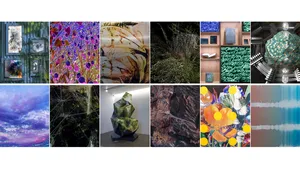Celebrating India’s Independence on Google Arts & Culture
Information can empower people, their cultures and their sense of history. It can also help us understand the world around us today. That’s why we built Google Arts & Culture — to put the world’s cultural treasures at anyone’s fingertips and help museums and other cultural organizations share more of our diverse heritage with the world.
Today, ahead of the Independence Day of India on August 15, we’re launching a new collection: ‘India Ki Udaan’, published in English and Hindi. This collection celebrates India’s unwavering spirit and its 75 years of independence, and the literal title translation means “India takes flight”. It allows anyone to explore more than 120 illustrations and 21 stories created by 10 talented artists, alongside exhibitions from various institutions across India — including the Ministry of Tourism, Museum of Art & Photography, Heritage Directorate of the Indian Railways, the Indian Academy of Sciences and the Dastkari Haat Samiti. This initiative offers a unique view of India and lets people discover some of the most memorable moments in India's modern history, its iconic personalities, its proudest scientific and sporting achievements, and how women in India continue to inspire the world.
Relive the moments of a newly independent India
On August 15, 1947, India gained independence from British rule following the Independence Movement led by Mahatma Gandhi and his message of nonviolent resistance. ‘India Ki Udaan’ takes people back to the Independence Day Celebrations in 1947 and Jawaharlal Nehru being sworn in as the first Prime Minister of Independent India. It tells the story of how the Indian Constitution was drafted over three years, as well as India’s first general elections which consisted of a sixth of the world’s population going to vote — making it the largest election in the world at the time. Explore the majestic Red Fort, lying at the heart of Delhi, where India’s Prime Minister hoists the National Flag from the monument's ramparts each year on Independence Day.
Discover the steps of progress
In December 1946, Sarojini Naidu, one of the women members of the Constituent Assembly, said during the First Session of the Constituent Assembly: “[…] I hope the smallest minority in this country will [...] be represented.” In 2015, Madhu Bai Kinnar made history when she became India’s first transgender Mayor in Chhattisgarh’s Raigarh Municipal Corporation. Another important step was the historic Decriminalization of Section 377 on September 6, 2018, when homosexuality was legalised and love was constitutionally recognised. Each of these victories have opened doors for a more hopeful future.
The photo shows Jawaharlal Nehru being sworn in as First Prime Minister of Independent India on August 15, 1947.
Mahatma Gandhi is perhaps the most celebrated Indian public figure in the world. His ideas and words have influenced many of the world's most powerful political leaders, freedom fighters, social activists, thinkers, and artists alike: from Martin Luther King to Nelson Mandela to John Lennon.
The Constitution of India was adopted on January 26, 1950. The 299 member Constituent Assembly drafted the Constitution of India over three years. The first meeting of the Constituent Assembly was attended by 205 members, including 9 women.
On January 4, 2015, Madhu Bai Kinnar made history when she became India’s first transgender Mayor in Chhattisgarh’s Raigarh Municipal Corporation.
On September 6, 2018, the Supreme Court of India decriminalized homosexuality. A five-judge constitutional bench struck down the 1861 colonial-era law, which remained in force for 157 years.
Named after a prominent Indian astronomer and mathematician of the 5th century CE, the Aryabhata was India's first satellite. It carried scientific instruments to explore conditions in Earth’s ionosphere, measure neutrons and gamma rays from the Sun, and perform investigations in X-ray astronomy.
Wing Commander Rakesh Sharma, an Indian Air Force pilot, is the first Indian citizen to have traveled to outer space. Sharma spent 7 days, 21 hours, and 40 minutes aboard the Salyut 7 during which his team conducted scientific and technical studies.
Learn about India's achievements in outer space
Did you know that India had its own Antarctic research base? Or that India’s first uncrewed satellite was launched in 1975? On that day, India became the world’s 11th nation to send a satellite into orbit. Nine years later, Rakesh Sharma became the first Indian who traveled beyond Earth.
…and in sports
Nikhat Zareen won the gold medal at the 2022 IBA Women’s World Boxing Championships, in Istanbul.
Milkha Singh, known as the Flying Sikh, is the only athlete to win gold at 400 meters at the Asian Games and the Commonwealth Games, in 1958.
India’s Olympic gold in field hockey in 1948 was the newly sovereign nation’s first major sporting triumph.
In 1983, the India cricket team defeated the West Indies by 43 runs at the Lord's Cricket Ground in London, winning its first World Cup.
Get inspired by Indian women
Women in India have played a huge part in shaping the rich culture of the country, revolutionizing the fields of science, technology, mathematics, politics and more. Meet Rajkumari Amrit Kaur, India’s first Health Minister – an enormous breakthrough for women’s representation in the newly independent country. Learn about more firsts: Leila Seth, the first female Chief Justice of India, and Bhanu Athaya, the first Indian Oscar winner. Or get to know Anuradha T.K., a scientist who joined the Indian Space Research Organisation (ISRO) in 1982, and became the first woman to be a satellite project director there. Or Vidita Vaidya, a neuroscientist who studied emotions and the brain, particularly when it came to depression.
10 years of Google Arts & Culture in India
Time flies when you’re working on something you’re passionate about. Google Arts & Culture’s journey in India started in 2012 when the National Museum and National Gallery of Modern Art joined our platform, and has since continued. We are proud to have partnered with local institutions to bring India’s cultural heritage to people all around the world – from immersive tours of World Heritage Sites like the Taj Mahal and Hampi, to close-ups of Raja Varma’s lavish paintings, unforgettable journeys by Indian Railways, and detailed stories about pioneering Indian women.
Today, millions of people from across the world can explore 2,100 exhibitions provided by over 100 partners in India. They can also experience incredible India in 360 degrees, as never seen before. Take a journey across Hampi, Goa, Delhi and Amritsar, and explore the places and people that make each of these iconic Indian sites incredible.
Discover the story behind jutti - a type of leather shoe decorated with extensive embroidery.
In this soft, naturalistic painting of a young woman, the aristocratic Raja Varma introduced a new visual language to Indian art. This sensuous portrait remains one of his most affecting works.
Test your knowledge of India’s art forms with Guess That Craft and see how India's unique craftsmanship helps define this nation.
The Taj Mahal needs no introduction. Built by emperor Shah Jahan in memory of his wife Mumtaz Mahal, the marble mausoleum is one of the crowning achievements of the Mughal Empire and one of the seven Wonders of the World. Experience this great monument through a virtual tour.
Sanchi Stupa, a Buddhist complex, is one of the oldest stone structures in India and an important monument of Indian Architecture. It’s famous for its Great Stupa – which translates roughly as “heap” from Sanskrit. You can also explore it in 3D.
Though millions use this train station every day, the majesty of the Chhatrapati Shivaji Maharaj Terminus never goes unnoticed. You can explore it in 360 degrees at Google Arts & Culture.
Āyurveda, the ‘Science of Life’, originated in ancient India and is thought to be one of the earliest medical sciences in the world. Discover the various ingredients used in Āyurveda medicine.
As the Mughal kings traveled around their kingdom, they slept in adorned tents called Kanat. This lavish tent hanging of the early 18th century is befitting of the royal entourage.
Standing Buddha is an aesthetically stunning example of Gupta art. The Buddha’s following grew even further in the years after his passing, and he became a frequent subject of Indian art. Follow the stages of his life depicted through sculpture.
This painting of a divine woman robed in saffron is an early depiction of Bharat Mata, or ‘Mother India’ – a personification of India as a mother goddess. You can study Abanindranath Tagore’s painting also in augmented reality on your smartphone.
To our more than 100 Indian partners, a huge thank you. And by partners, we mean everyone: curators taking the time to create a stunning online exhibition, the art handlers who help digitize thousands of spaces and archives, the preservation expert sharing fragile treasures, the directors who believe in participating in an online platform, and everyone else behind the scenes.
We hope that the merging of new technologies and India’s rich cultural heritage will provide many more opportunities to share compelling stories, exhibits and experiences that can be enjoyed by anyone, wherever they might be. As we go forward, we’ll continue to work with partners and artists to enrich the collection.







